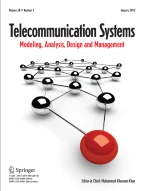Abstract
Pilot contamination is one of the main impairments in multi-cell massive Multiple-Input Multiple-Output systems. In order to improve the channel estimation in this context, we propose to use a semi-blind channel estimator based on the constant modulus algorithm (CMA). We consider an enhanced version of the CMA namely the Modified CMA which modifies the cost function of the CMA algorithm to the sum of cost functions for real and imaginary parts. Due to pilot contamination, the channel estimator may estimate the channel of a contaminating user instead of that of the user of interest (the user for which the Base Station wants to estimate the channel and then the data). To avoid this, we propose to scramble the users sequences before transmission. We consider different methods to perform unitary scrambling based on rotating the transmitted symbols (one Dimensional (1-D) scrambling) and using unitary matrices (two-Dimensional (2-D) scrambling). At the base station, the received sequence of the user of interest is descrambled leading to a better convergence of the channel estimator. We also consider the case where the Automatic Repeat reQuest protocol is used. In this case, using scrambling leads to a significant gain in terms of BLock Error Rate due to the change of the contaminating users data from one transmission to another induced by scrambling.
Similar content being viewed by others
Explore related subjects
Discover the latest articles, news and stories from top researchers in related subjects.References
Lu, J. L., Li, G. Y., Swindlehurst, A. L., Ashikhmin, A., & Zhang, R. (2014). An overview of massive MIMO: Benefits and challenges. IEEE Journal of Selected Topics in Signal Processing, 8(5), 742–758.
Larsson, E. G., Edfors, O., Tufvesson, F., & Marzetta, T. L. (2014). Massive MIMO for next generation wireless systems. IEEE Communications Magazine, 52(2), 186–195.
Andrews, J. G., Buzzi, S., Choi, W., Hanly, S. V., Lozano, A., Soong, A. C. K., & Zhang, J. C. (2014). What will 5G be? IEEE Journal on Selected Areas in Communications, 32(6), 1065–1082.
Marzetta, T. L. (2010). Noncooperative cellular wireless with unlimited numbers of base station antennas. IEEE Transactions on Wireless Communications, 9(11), 3590–3600.
Leow, C. Y., Rahman, T. A., Nunoo, S., & Iliya, S. Z. (2016). A comprehensive survey of pilot contamination in massive MIMO-5G. IEEE Communications Surveys & Tutorials, 18(2), 905–923.
Hu, D., He, L., & Wang, X. (2016). Semi-blind pilot decontamination for Massive MIMO systems. IEEE Transactions on Wireless Communications, 15(1), 525–536.
Han, H.-D., Nguyen, D.-A., Nguyen, V.-D., Nguyen, T.-H., & Zia, M. (2018). Pilot decontamination for multi-cell massive MIMO systems using asynchrounous pilot design and data-aided channel estimation. Physical Communication, 76–85.
Nguyen, D.-A., Nguyen, A.-T., Han, H.-D., Nguyen, V.-D., & Zia, M. (2018). Pilot decontamination using time-shifted pilot and data-aided channel estimation for massive MIMO. IEEE ICCE, Vietnam.
Maruta, K., & Ahn, Ch.-J. (2018). Uplink interference suppression by semi-blind adaptive array with decision feedback channel estimation on multicell massive MIMO systems. IEEE Transactions on Communications, 66(12), 6123–6134.
Godard, D. N. (1980). Self-recovering equalization and carrier tracking in two-dimensional data communication systmes. IEEE Transactions on Communications, 28, 1867–1875.
Johnson, R., Schniter, P., Endres, T. J., Behm, J. D., Brown, D. R., & Casas, R. A. (1998). Blind equalization using the constant modulus criterion: a review. Proceedings of the IEEE, 86(10), 1927–1950.
Oh, K. N., & Chin, Y. O. (1995). Modified constant modulus algorithm: Blind equalization and carrier phase recovery algorithm. In IEEE Conference on Communications, USA.
Yang, J., Werner, J. J., & Dumont, G. A. (2002). The multimodulus blind equalization and its generalized algorithms. IEEE Journal on Selected Areas in Communications, 20(5), 997–1015.
Yang, J., Werner, J. J., & Dumont, G. A. (1997). The multimodulus blind equalization algorithm. IEEE ICDSP, Santorini, Greece.
Abrar, S., & Nandi, A. K. (2010). Blind equalization of square-QAM signals: A multimodulus approach. IEEE Transactions on Communications, 58(6), 1674–1685.
Sun, Y., Zhu, L., Li, D., & Liu, Z. (2019). Convex combination of SISO equalization and blind source separation for MIMO blind equalization. Wireless Personal Communications, pp. 1397–1409.
Maruta, K., & Ahn, Ch.-J. (2019). Enhanced semi-blind uplink interference suppression on multicell massive MIMO systems for multi modulus signals. IEEE VTC2019-Fall, pp. 1–6, USA.
Rekik, O., Mokraoui, A., Ladaycia, A., & Abed Meraim, K. (2019). Semi-blind source separation based on multi-modulus criterion? Application for pilot contamination mitigation in massive MIMO communications sytems. In IEEE ISCIT 2019, (Vol. 9(11), pp. 3590–3600).
Rekik, O., Abed Meraim, K., & Mokraoui, A. (2020). Multi-Modulus based semi-blind source separation for MIMO-OFDM communications systems. In IEEE SAM (pp. 1–5), China.
Comon, P. (2000). Block methods for channel identification and source separation. In IEEE ASSPCC (pp. 87–92). Lake Louise, AB, Canada.
Author information
Authors and Affiliations
Corresponding author
Ethics declarations
Conflict of interest
The authors declare that they have no conflict of interest.
Additional information
Publisher's Note
Springer Nature remains neutral with regard to jurisdictional claims in published maps and institutional affiliations.
Rights and permissions
About this article
Cite this article
Sellami, N., Siala, M. Semi-blind channel estimation based on modified CMA and unitary scrambling for massive MIMO systems. Telecommun Syst 79, 249–259 (2022). https://doi.org/10.1007/s11235-021-00856-0
Accepted:
Published:
Issue Date:
DOI: https://doi.org/10.1007/s11235-021-00856-0
